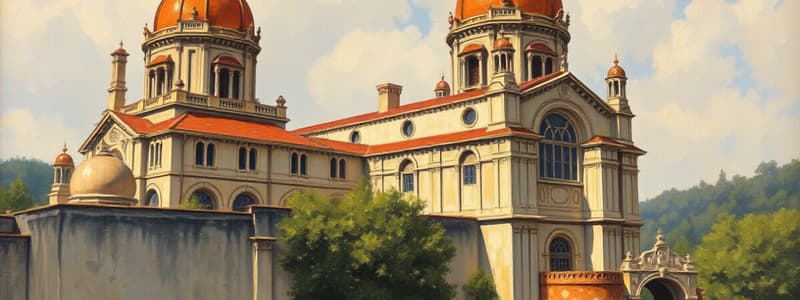Podcast
Questions and Answers
What is the term for a very tall building?
What is the term for a very tall building?
- Cottage
- Bungalow
- Skyscraper (correct)
- Warehouse
What building material is made from a mixture of iron and carbon?
What building material is made from a mixture of iron and carbon?
Steel
The __________ is a building reduced to a state of decay.
The __________ is a building reduced to a state of decay.
ruin
Concrete is a type of timber.
Concrete is a type of timber.
What is the term for a building that is made up of many different offices?
What is the term for a building that is made up of many different offices?
Which of the following is an example of a public building?
Which of the following is an example of a public building?
Match the following architectural styles with their characteristics:
Match the following architectural styles with their characteristics:
What is a mansion?
What is a mansion?
Which material is known for being very strong and allowing for large structures?
Which material is known for being very strong and allowing for large structures?
A balcony is found on the ground floor of a building.
A balcony is found on the ground floor of a building.
Flashcards are hidden until you start studying
Study Notes
Building Materials
- Timber: Wood used in construction.
- Stone: A natural solid substance; used structurally and decoratively.
- Steel: Strong metal made from iron and carbon, ideal for large structures.
- Glass: Transparent material; modern innovations allow for entire walls made of glass.
- Concrete: Mixture of cement, sand, stones, and water; popular for being strong and moldable.
- Reinforced Concrete: Concrete combined with steel to enhance strength, used in large structures like bridges.
- Marble: Polished stone known for its aesthetic patterns, famously used in the Taj Mahal.
Types of Buildings
- Skyscraper: Very tall buildings, often used for commercial purposes.
- Low-rise Apartment: Residential buildings with few floors.
- High-rise Apartment: Multi-storey residential buildings offering numerous units.
- Multi-storey Car Park: Parking facilities built in levels.
- Ruin: Buildings in a state of decay and collapse.
- Warehouse: Large storage buildings, often repurposed into apartments.
- Office Block: Buildings housing multiple offices, usually belonging to different companies.
- Heritage Sites: Important historical buildings that are preserved for their cultural significance.
- Detached House: Stand-alone residential units.
- Semi-detached House: Pair of houses sharing a wall.
- Terraced House: Row of identical houses connected by shared walls.
- Mansion: Large and impressive residential buildings.
- Cottage: Small, charming houses typically found in rural areas.
- Bungalow: Single or two-storey homes with wide porches.
- Castle: Fortified large buildings often used historically as residences.
- Palace: Vast and grand residences for royals.
- Shopping Centre/Mall: Complex of retail stores, dining, and entertainment options.
- Landmark: Prominent buildings or structures that help establish location recognition.
- Public Building: Structures owned by government entities for public use, e.g., libraries or museums.
Parts of a Building
- Porch: Covered entrance area of a building.
- Façade: The front or face of a building, often decorative.
- Balcony: A platform projecting from the building, typically enclosed by a railing.
- Cellar: Underground storage space, often for wine.
- Roof: Top covering of a building, providing protection.
- Pillar: Vertical structures designed to support weight.
- Attic: Space under the roof, often used for storage.
- Staircase: Series of steps connecting different floors.
- Basement: Below-ground level part of a building, often used for storage or utilities.
- Exterior: The outer surface or structure of the building.
- Interior: The internal spaces and decorations of a building.
- Dome: Rounded roof structure, recognized in iconic buildings like the Hagia Sophia.
Aesthetic Perception
- Well-designed: Professionally crafted for visual appeal.
- An Eyesore: Unattractive building that detracts from surroundings.
- Elegant: Stylish and tasteful design.
- Controversial: Designs that evoke strong differing opinions.
- Pleasing Geometric Forms: Attractive shapes used in design.
- Stunning: Extremely impressive or beautiful architecture.
- Eye-catching: Highly attractive features that draw attention.
- Iconic: Symbolic architecture representing a place, such as the Sydney Opera House.
- State-of-the-art: Incorporating modern technologies and trends.
- Groundbreaking / Innovative: Incorporating new, creative concepts in design.
- Spacious: Generously sized areas within buildings.
Architectural Style
- Modernist: Features simple designs with glass and steel; lacks decorative elements.
- Post-modern: Colorful, varied styles that combine different architectural influences.
- Standardized: Design elements that conform to set patterns or regulations.
- Traditional: Architecture that follows historical and cultural practices.
- International Style: Emphasizes functionality and minimalism with global design appeal.
- Art Deco: Defined by geometric shapes and streamlined designs inspired by nature and technology.
- High Tech: Incorporates industrial elements and advanced technology into building design.
Studying That Suits You
Use AI to generate personalized quizzes and flashcards to suit your learning preferences.




